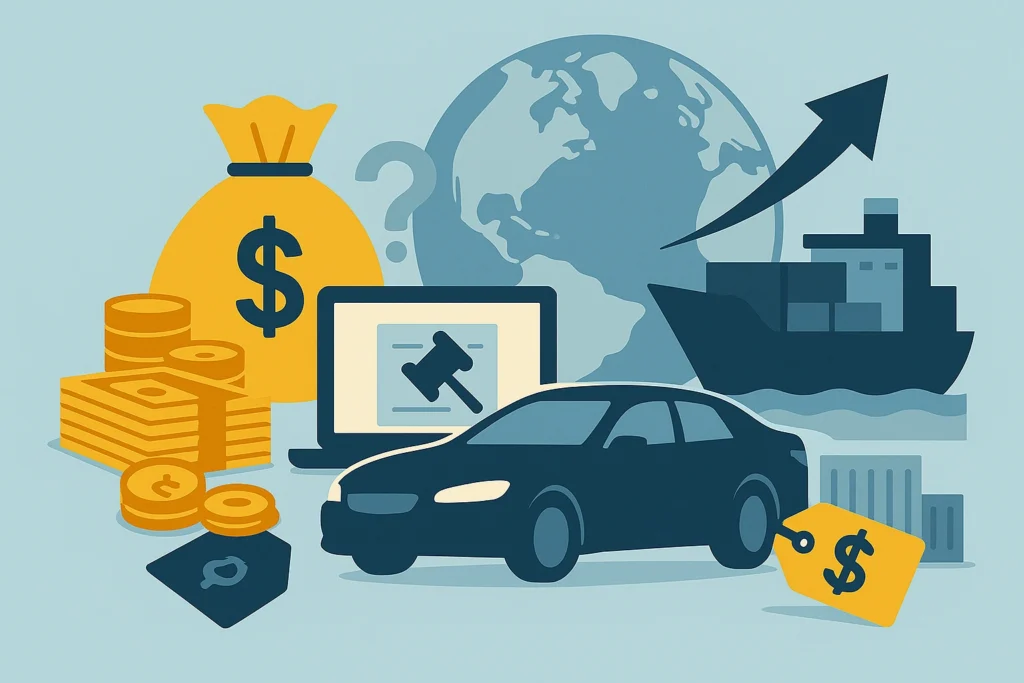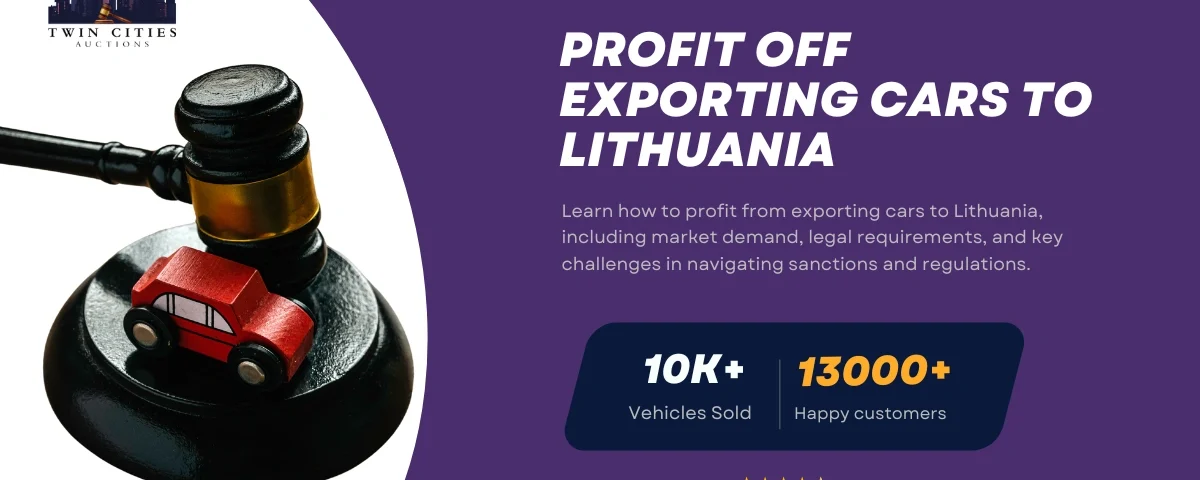Lithuania’s appetite for imported vehicles is on the rise, Baltic ports saw nearly 200,000 motor‑vehicle arrivals in 2023, valued at around €3 billion. With Euro 6 compliance and modern fleets in demand, U.S. exporters have unlocked margins of 15–20 percent in under six months.
Below, you’ll find Lithuania’s confirmed import requirements, cost breakdowns, and logistics routes, plus steps to obtain the precise passenger‑car data you need to fine‑tune your strategy.

Key Takeaways
- Lithuania imported approximately 180,000–210,000 vehicles in 2023, solidifying its role as a significant automotive entry point into Eastern Europe.
- Import duties and VAT combine to a total of 31% on the CIF value, impacting the overall cost structure for vehicle importers.
- Profit margins for U.S. exporters typically range between 15–20%, achievable within a six-month turnover period due to efficient logistics and market demand.
- Klaipėda serves as the primary port for vehicle imports, offering robust connections via the Rail Baltica corridor to inland European markets.
- Essential import documentation includes a commercial invoice, bill of lading, import declaration, and a certificate of conformity, ensuring compliance with EU regulations.
Understanding the Lithuanian Market
Lithuania has rapidly grown into a major vehicle re-export hub for Eastern Europe, thanks to its strategic location and EU membership.
Demand is fueled by domestic needs and buyers from neighboring non-EU countries like Belarus and Ukraine. Popular imports include compact cars, diesel vehicles, and late-model crossovers that align with affordability and efficiency.
Exporters can benefit from Lithuania’s simplified customs processes and strong logistics infrastructure.
| Metric | Figure |
| Vehicles Imported (all types) | 180,000–210,000 units |
| Market Value | €2.8–€3.2 billion |
| Year‑over‑Year Growth | ~8 percent |
Source: OEC – The Observatory of Economic Complexity (https://oec.world)
Regulations and Compliance
As an EU member, Lithuania applies the Common External Tariff and EU rules:
| Requirement | Details |
| Import Duty | 10 percent of CIF |
| Value Added Tax (VAT) | 21 percent on CIF plus duty |
| Emissions Standard | Euro 6 for all imports |
| Vehicle Age Limit | Up to 5 years (older require EU type‑approval) |
| Certificate of Conformity | Mandatory from an EU‑approved lab |
| Import Declaration | Filed via Customs Logistics Terminal (CLT) |
Source: Lithuanian Customs (https://lrmuitine.lt/en)
Building Your Landed‑Cost Model
It’s essential to account for hidden charges like document translation, customs broker fees, and inland transport within Lithuania.
Seasonal fluctuations in VAT filing periods may also impact when costs are settled, potentially affecting your cash flow.
Setting a markup without fully accounting for fluctuating port handling fees or currency conversion rates can lead to unprofitable margins. Use a dynamic pricing model and regularly update inputs to protect profitability.
For a €20,000 vehicle:
| Cost Item | Rate | Calculation Example |
| CIF Cost | — | €20,000 |
| Import Duty | 10 percent | €2,000 |
| VAT | 21 percent | (20,000 + 2,000) × 0.21= 4,620 |
| Miscellaneous Fees | ~1 percent | €20,000 × 0.01= €200 |
| Total Landed | — | €26,820 |
Source: Lithuanian Customs (https://lrmuitine.lt/en)
Add your target markup (15–20 percent) to set your sale price.
Logistics and Shipping Routes
Lithuania’s principal port is Klaipėda, with Rail Baltica links to inland markets.
Lithuania’s Klaipėda port is highly efficient, serving as a key entry point for goods bound for the Baltics, Scandinavia, and Eastern Europe.
Containerized shipping is the most secure option, especially for high-value or EV units, while breakbulk remains popular for large-volume exports.
Rail Baltica is a game-changer for distributing vehicles inland, offering fast overland routes to Poland and beyond. Be mindful of winter shipping schedules, as weather can delay Baltic Sea routes.
| Route | Transit Time | Notes |
| U.S. East Coast → Klaipėda | 15–18 days | Container services via Hamburg |
| U.S. Gulf Coast → Klaipėda | 18–22 days | Breakbulk options available |
| U.S. West Coast → Klaipėda | 25–30 days | Via Suez and Baltic Sea routes |
Source: Maersk (https://www.maersk.com/)
Financing and Payment Security
Due diligence is key when dealing with new buyers in the Lithuanian market, especially those acting as intermediaries for third-party resale.
Letters of credit remain the gold standard for mitigating risk, particularly on high-value loads or first-time transactions.
Escrow accounts add an extra layer of security, particularly for smaller independent dealerships. Always clarify Incoterms in contracts to avoid disputes over delivery responsibilities and cost liabilities.
Standard payment methods:
| Method | Risk Level | Best Use |
| Letter of Credit | Low | New clients; large shipments |
| Open Account | High | Established, trusted buyers |
| Escrow | Medium | Guarantees delivery before payment |
Source: U.S. Export‑Import Bank (https://www.exim.gov/)
Hedge EUR/USD exposure with forward contracts via major banks.
Common Pitfalls to Avoid
- Under‑estimating VAT or duty erodes profit
- Missing Euro 6 certification delays clearance
- Neglecting to secure precise passenger‑car import figures
Why Auctions Are a Smart Choice for Car Purchases
Auctions can be an excellent source for late-model vehicles with clear chains of title and affordable pricing. Twin Cities Auctions, based in Minnesota, is one such reputable auction house that offers a wide range of vehicles at competitive prices.
Key Benefits of Buying from Auctions:
- Wide Selection: Auctions like Twin Cities Auctions offer a variety of vehicles, from low-budget cars to high-end models.

- Competitive Pricing: Auctions often offer vehicles at prices below retail value, enabling dealers to maximize their profit margins.

- Transparency: Auctions provide full vehicle history reports, so you know exactly what you’re buying.

- Convenient Bidding: Many auctions offer online bidding for your convenience, making it easier to source vehicles without being physically present.
Twin Cities Auctions: A Smart Vehicle Sourcing Choice
For those in the automotive industry, Twin Cities Auctions offers an excellent platform for sourcing quality vehicles at competitive prices.
Whether you are just starting or expanding your business, this auction house provides transparency, competitive pricing, and a broad selection.
| Feature | Description |
| Inventory Variety | Wide range of cars, trucks, and SUVs available |
| Competitive Pricing | Below-market pricing allows for higher profit margins |
| Vehicle History Reports | Detailed history reports for every vehicle |
| Online Bidding | Convenient online bidding options for dealers |
| Financing Options | Financing available to help with inventory purchases |
Conclusion
Lithuania’s import market offers strong demand for modern, reliable vehicles. By following EU‑aligned rules, accurately modeling landed costs, optimizing logistics, and securing precise passenger‑car data, U.S. exporters can achieve robust profit margins and sustainable growth.
Ready to Buy or Sell Your Car? No Dealer License Needed!
At Twin Cities Auctions, we simplify the process of buying and selling vehicles, making it straightforward and hassle-free. You don’t need a dealer license to participate—our online platform is open to the public, accommodating both first-time buyers and seasoned sellers.
Whether you’re upgrading your ride or selling your current vehicle, we provide the platform you need that offers a diverse range of vehicles and a transparent bidding process. Start your auction journey with us today!
Looking for more options? Explore our comprehensive list of all available car auctions across the United States. Your next deal might be just a click away!
FAQ
What are Lithuania’s auto import duties?
Duty is 10 percent of CIF value.
What VAT applies?
VAT is 21 percent on CIF plus duty.
Can I export used cars to Lithuania?
Yes—vehicles up to five years old; older require EU type‑approval.
How long does customs clearance take?
Typically 3–5 business days with full documentation.
Are emissions standards enforced?
Yes—Euro 6 compliance is mandatory.


